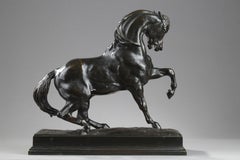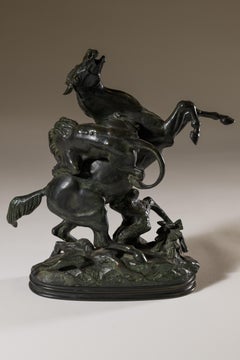Antoine Barye Horse
1880s French School Figurative Sculptures
Bronze
Late 19th Century French School Figurative Sculptures
Bronze
1880s French School Figurative Sculptures
Bronze
Late 19th Century French School Figurative Sculptures
Bronze
Recent Sales
19th Century Still-life Sculptures
Bronze
1880s French School Figurative Sculptures
Bronze
1880s Naturalistic Figurative Sculptures
Bronze
People Also Browsed
1730s Old Masters Animal Paintings
Oil
Early 20th Century European Art Nouveau Vases
Bronze
21st Century and Contemporary Modern Lounge Chairs
Fabric, Upholstery
Antique 1870s French Beaux Arts Figurative Sculptures
Bronze
Early 20th Century Italian Art Deco Table Lamps
Onyx, Marble
18th Century Old Masters Portrait Paintings
Oil
Early 20th Century French Art Deco Animal Sculptures
Marble, Metal
21st Century and Contemporary Portuguese Modern Sofas
Fabric, Wood, Bouclé
20th Century French Desks and Writing Tables
Brass, Bronze
Vintage 1980s Italian Art Nouveau Sterling Silver
Sterling Silver
Antique Late 19th Century European Moorish Architectural Elements
Wrought Iron
Antique 19th Century Chinese Beds and Bed Frames
Gold Leaf
2010s Portuguese Modern Lounge Chairs
Brass
Vintage 1940s French Art Deco Wall Lights and Sconces
Iron
Antique Late 19th Century French Belle Époque Figurative Sculptures
Spelter
Vintage 1960s Italian Mid-Century Modern Animal Sculptures
Blown Glass
Antoine Barye Horse For Sale on 1stDibs
How Much is a Antoine Barye Horse?
Antoine-Louis Barye for sale on 1stDibs
The son of a goldsmith, Parisian born Antoine-Louis Barye was a sculptor of animal subjects and acclaimed, not only for his apparent skill but as the founder of what became known as the French Animaliers School. Among his patrons were representatives of the state government and royalty, including the Duke of Orleans and the Dukes of Luynes, Montpensier and Nemours.
Well compensated financially, Barye was able to buy the best of materials and hire the country's most skilled foundry craftsmen. The foundry he hired was owned by Ferdinand Barbedienne and casts from this period were stamped with the letters, FB. However, he did not make a lot of money from his work because he was such a perfectionist that often he would not sell his work because he thought it was not "quite right." In 1848, he declared bankruptcy and his molds and plaster casts were sold along with the copyrights.
Barye's specialty was aroused, angry-seeming wild game such as lions and tigers and elephants, but he also did equestrian groups and mythology figures. In order to do realistic depictions of animal anatomy, he spent much time at the Jardin des Plantes in Paris. His early training was as an apprentice to a metal engraver, but being drafted in the army in 1812 ended that education. In 1832, he had established his studio, and unique at that time was his method of cold stamping his bronze casts so that each one had a special number. He had his first entry, The Milo of Croton, in the Paris Salon in 1819, winning a second prize. In 1831, a work regarded as a masterpiece, Tiger Devouring a Gavial, was in the Salon and purchased for the Luxembourg Gardens, which is now in the Louvre. However, many of his subsequent Salon submissions were rejected and so angered him that between 1836 and 1851, he refused to submit entries. In 1851, he again exhibited at the Salon with Jaguar Devouring A Hare, and this work, like the 1831 entry, was placed in the Luxembourg Gardens and eventually in the Louvre.
In spite of problems with the Salon, Barye received many accolades for his work, and the period of 1837–48 was considered the most productive time of his career. However, in 1848, when he lost control of his work and it was reproduced by others including Martin and Barbedienne, the sculptures, according to some art professionals, are not as skillfully executed. In 1848, after his bankruptcy, Barye became director of Casts and Models in the Louvre, until 1850, when he was replaced by Emmanuel Fremiet. It was a very difficult time for him. However, within a few years, he began receiving accolades for the quality and uniqueness of his work, and people began appreciating the powerful images of his sculpture, especially the wildlife in their natural surroundings. In 1854, he was appointed Master of Zoological Drawing in the Musée National d'Histoire Naturelle and held this position until his death in 1875.
Finding the Right Figurative-sculptures for You
Figurative sculptures mix reality and imagination, with the most common muse being the human body. Animals are also inspirations for these sculptures, along with forms found in nature.
While figurative sculpture dates back over 35,000 years, the term came into popularity in the 20th century to distinguish it from abstract art. It was aligned with the Expressionist movement in that many of its artists portrayed reality but in a nonnaturalistic and emotional way. In the 1940s, Alberto Giacometti — a Swiss-born artist who was interested in African art, Cubism and Surrealism — created now-iconic representational sculptures of the human figure, and after World War II, figurative sculpture as a movement continued to flourish in Europe.
Lucian Freud and Francis Bacon were some of the leading figurative artists during this period. Artists like Jeff Koons and Maurizio Cattelan propelled the evolution of figurative sculpture into the 21st century.
Figurative sculptures can be whimsical, uncanny and beautiful. Their materials range from stone and wood to metal and delicate ceramics. Even in smaller sizes, the sculptures make bold statements. A bronze sculpture by Salvador Dalí enhances a room; a statuesque bull by Jacques Owczarek depicts strength with its broad chest while its thin legs speak of fragility. Figurative sculptures allow viewers to see what is possible when life is reimagined.
Browse 1stDibs for an extensive collection of figurative sculptures and find the next addition to your collection.

